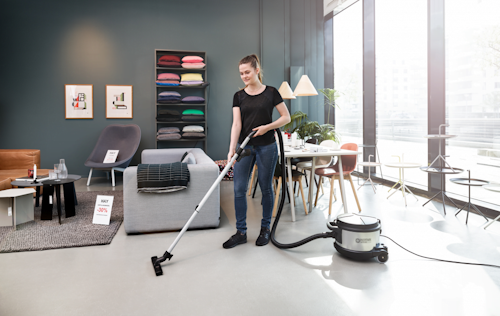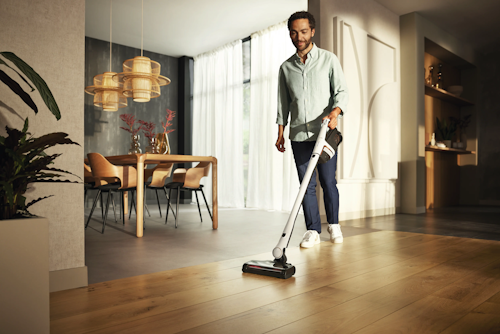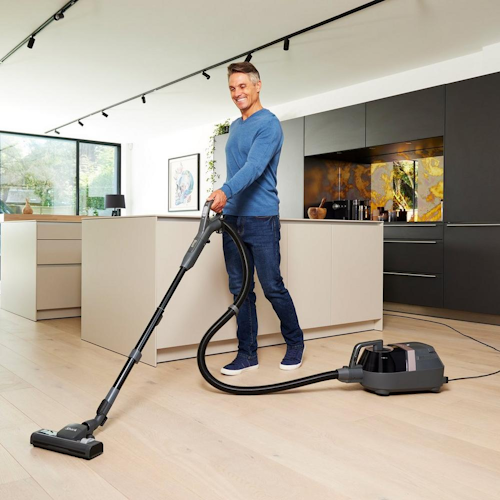Imagine this: you step into your cozy home after an exhausting day, eager to sink into comfort and unwind. However, instead of the relief you yearn for, you are greeted by a barrage of relentless sneezes and eyes that itch incessantly, refusing to grant you peace. Alternatively, picture yourself seated in a stuffy conference room at work, attempting to concentrate on a crucial meeting, yet the air is heavy with dust, leaving your throat feeling raw and scratchy. These situations, familiar to many, underscore how allergies can stealthily infiltrate our surroundings and significantly affect our well-being.
One promising solution to this persistent issue lies in vacuum cleaners equipped with HEPA (High-Efficiency Particulate Air) filters. These sophisticated devices are specifically engineered to trap and lock away allergens, promoting cleaner and healthier air for everyone involved. As numerous individuals seek effective remedies to combat these challenges, the question arises: What exactly is a HEPA vacuum, and can it truly alleviate allergies?
This blog takes an in-depth look into the science behind HEPA filters, examining their prowess in capturing microscopic allergens and how their integration into your home or workplace can foster a healthier environment. Join us on this exploration of the numerous benefits offered by HEPA filters and uncover practical strategies to lessen allergy symptoms, ultimately enhancing your overall quality of life.
What is a HEPA Vacuum?
A HEPA vacuum, often referred to as a HEPA filter vacuum, is a specialized cleaning device meticulously engineered to trap microscopic particles that typical vacuums frequently overlook. These remarkable machines are equipped with filters adhering to stringent industry standards, capable of capturing an impressive 99.97% of particles as minuscule as 0.3 microns. This includes a wide array of potential allergens such as dust, pollen, pet dander, mold spores, and even some bacteria. Their exceptional filtration capability makes them particularly advantageous for individuals sensitive to allergens, providing a noticeable relief in air quality.
The design of HEPA vacuums often incorporates a sealed system to prevent the slightest chance of leaks, ensuring that the captured particles remain securely confined within the vacuum and are not inadvertently released back into your home. This containment feature is crucial to the unparalleled performance and efficacy of these devices. Coupled with cutting-edge suction technology, these vacuums are capable of delivering an exceptionally deep clean, which significantly contributes to a healthier and more pristine living environment.
A HEPA vacuum is a versatile and robust cleaning tool, perfectly suited for tackling a variety of surfaces such as plush carpets, smooth hardwood floors, upholstered furniture, and even mattresses. To sustain its high level of efficiency, it is essential to understand the proper method for cleaning a HEPA filter. Regular and diligent maintenance ensures that these vacuums continue to effectively reduce allergens, promoting a healthier and more comfortable living space for many years to come.
Do HEPA Filters Help with Allergies?
High-Efficiency Particulate Air (HEPA) filters for vacuum cleaners have been scientifically proven to alleviate allergy symptoms by significantly reducing allergens and enhancing air quality. In homes equipped with HEPA filtration systems, occupants often experience a noticeable decrease in dust mites, pollen, and other airborne irritants. A study published in the Journal of Allergy and Clinical Immunology confirms these findings, highlighting the remarkable reduction in allergens in homes where HEPA filter vacuums are consistently employed. These devices have become essential tools for managing allergies, their effectiveness underscored by empirical evidence.
Personal anecdotes further reinforce the advantages of HEPA vacuums. Many allergy sufferers report marked relief from symptoms such as persistent sneezing, bothersome nasal congestion, and irritating eye discomfort after integrating HEPA vacuums into their cleaning routines. These improvements are particularly pronounced in households with pets or in environments where allergen exposure is high. This underscores the importance of understanding how a HEPA vacuum operates, capable of capturing and eliminating harmful particles to enhance everyday life.
By incorporating HEPA vacuuming into regular cleaning schedules, individuals and organizations can cultivate cleaner, healthier indoor environments. This practice not only promotes overall well-being but also enhances comfort, transforming spaces into havens of health and tranquility.
Advantages of HEPA Vacuums Over Regular Vacuums
Superior Filtration Efficiency
The American College of Allergy, Asthma, and Immunology highlighted that HEPA vacuums boast an impressive ability to remove up to 99.97% of dust, pollen, and airborne particles as minuscule as 0.3 microns. This exceptional level of filtration ensures that these potentially harmful particulates are trapped securely within the vacuum, preventing them from being recirculated back into the living space.
The significance of such thorough filtration is particularly crucial for individuals suffering from allergies or respiratory conditions, as even the tiniest particles can provoke uncomfortable symptoms. By utilizing HEPA filters in vacuum cleaners, these advanced devices effectively diminish allergens like dust mites, pet dander, and mold spores, ensuring they don’t linger invisibly in the environment. The result is a cleaner, healthier atmosphere, free from the microscopic irritants that can aggravate sensitive respiratory systems.
Reduction of Allergens in the Air
HEPA vacuums are meticulously engineered to capture minute particles that often go unnoticed, such as dust mites, pet dander, and fungal spores, ensuring they do not recirculate in your living space. According to research published in the Pediatric Allergy and Immunology journal, these vacuums are remarkably effective in enhancing indoor air quality. They achieve this by significantly reducing the dust mite allergens tangled within the fibers of carpets and nestled into the fabric of furniture by up to an impressive 80%.
The impact of HEPA vacuums extends beyond just cleaner air; they can profoundly influence how you feel on a daily basis. A study featured in Allergologia et Immunopathologia reveals that individuals utilizing HEPA technology experienced a notable alleviation in allergy symptoms, with respiratory issues decreasing by as much as 60%. These vacuums tackle not only the allergens floating in the air but also those accumulating on surfaces. When used in conjunction with air purifiers, they craft a living environment that is noticeably more comfortable and inviting.
To fully harness the advantages of your HEPA vacuum, it is essential to use it regularly and maintain its filters diligently. Incorporating this routine with additional strategies, such as managing indoor humidity, can further uplift your home’s air quality, transforming it into a sanctuary of relaxation and ease.
Improved Indoor Air Quality
Utilizing a HEPA vacuum plays an essential role in significantly improving indoor air quality, an element often overlooked but vital for sustaining health and well-being. Studies have demonstrated that indoor air can be up to five times more contaminated than outdoor air, primarily due to the accumulation of dust, allergens, and other microscopic particles that traditional vacuums fail to capture.
A comprehensive study published in The Journal Environments highlighted that the use of HEPA vacuums led to a remarkable 30% to 60% decrease in allergy symptoms and respiratory issues among residents. Furthermore, the benefits of enhanced air quality extend beyond those with allergies—it is associated with heightened concentration, better sleep quality, and an increase in overall productivity. This makes HEPA vacuums an invaluable addition to both homes and workplaces, enriching the air we breathe and promoting a healthier living and working environment.
What Makes HEPA Filters Unique
High-Efficiency Particulate Air (HEPA) filters are characterized by rigorous standards that meticulously define their proficiency in capturing airborne particles. To earn the designation of a HEPA filter, a device must successfully trap at least 99.97% of particles that are 0.3 microns in size. This particular size is crucial because it signifies the most penetrating particle size (MPPS), illustrating that HEPA filters are exceptionally adept at capturing particles of this size. These particles include common allergens such as dust, pollen, and mold spores, which can significantly impact indoor air quality.
The standards governing HEPA filters are meticulously established by authoritative bodies like the U.S. Department of Energy. These standards ensure that consumers receive products that are not only capable of providing substantial air purification benefits but also live up to their claims. This comprehensive vetting process instills confidence in users, assuring them that HEPA filters will reliably deliver the air quality improvements they promise, safeguarding indoor environments from harmful particulates.
Mechanism of Action in Capturing Particles
HEPA filters achieve their remarkable level of filtration through a sophisticated combination of three mechanisms: interception, impaction, and diffusion. Interception occurs when tiny particles drift through the filter and come into direct contact with the densely packed fibers, becoming ensnared as if caught in a web. Impaction happens when larger particles, unable to gracefully navigate the twists and turns of the air stream, collide head-on with the fibers, embedding themselves into the intricate mesh. Lastly, diffusion targets the smallest particles, which dance erratically due to the random nature of Brownian motion, making them wander aimlessly until they are inevitably captured by the filter’s fibers.
This complex and finely-tuned mechanism allows HEPA filters in vacuum cleaners to continuously capture and hold onto a multitude of particles, ensuring users enjoy a pristine and safe environment. By delving into the workings of a HEPA filter, consumers can truly appreciate their unparalleled effectiveness in eliminating allergens and significantly enhancing the quality of indoor air.
Comparison with Standard Filters
When comparing HEPA filters with standard filters, the differences in performance become vividly apparent. Standard filters, often crafted from materials such as fiberglass or polyester, generally exhibit significantly lower filtration efficiency when it comes to particles 10 microns or smaller. While these filters are somewhat capable of capturing larger particles, they fall short in effectively trapping allergens and tiny pollutants, as highlighted in the journal Lung India.
In stark contrast, HEPA filters are constructed from dense mats of fine glass fibers intricately woven together to form a formidable barrier. This meticulous design enables HEPA filters to efficiently ensnare even the minutest particles. The heightened efficiency of these filters makes them the preferred option for individuals aiming to minimize allergens and enhance air quality in their homes and workplaces.
How HEPA Vacuums Eliminate Allergens
Capturing Dust Mites and Pet Dander
Dust mites and pet dander are common indoor allergens that often trigger allergic reactions in individuals with sensitivities. These tiny, almost invisible particles can easily become airborne, leading to sneezing, itchy eyes, and even asthma attacks. HEPA vacuums, a proven solution for those questioning the efficacy of HEPA filters in managing allergies, are specifically engineered to capture these pesky allergens, preventing them from swirling around the air we breathe.
With a blend of powerful suction and advanced HEPA filtration technology, these vacuums ensure that dust mites, which thrive in warm and humid environments like plush carpets and cozy bedding, are effectively sucked up and removed. Research published in the Journal of Asthma highlights that using a HEPA vacuum not only diminishes the presence of dust mite allergens but also alleviates allergy symptoms such as persistent sneezing and troublesome asthma attacks.
Moreover, numerous studies have shown that HEPA vacuums significantly curtail allergen levels in homes with furry companions. For instance, research has demonstrated that these vacuums are adept at capturing fine particles like pet dander and other airborne irritants, making them an invaluable tool for maintaining cleaner, healthier indoor environments.
The same study underscores that HEPA vacuums are crucial in controlling pet dander, a major source of allergens. Unlike standard vacuums, those equipped with HEPA filters are designed to trap even the minutest particles, capturing up to 99.97% of particles as tiny as 0.3 microns, including those pesky pet allergens. Regular use of these vacuums in homes with pets has been shown to reduce surface allergen concentrations by 50 to 80%, providing significant relief for allergy sufferers and helping to create a more comfortable living space.
Removing Pollen and Mold Spores
A study highlighted in the Journal of the Egyptian Society of Parasitology revealed that HEPA vacuums are remarkably effective in capturing pollen and mold spores, an often-overlooked set of allergens. These microscopic particles, nearly invisible to the naked eye, frequently infiltrate homes through the slightest openings such as open windows or doors. This is particularly true during the height of pollen seasons, when the air is thick with these irritants, or in damp environments where mold eagerly flourishes. By deploying a HEPA vacuum, homeowners can intercept these allergens before they settle indoors, thus dramatically alleviating allergy symptoms.
The prowess of HEPA vacuums in trapping both pollen and mold spores renders them an essential asset for preserving an immaculate indoor atmosphere. When pollen accumulates inside, it can trigger a cascade of symptoms such as incessant sneezing, watery and itchy eyes, and persistent respiratory irritation. Meanwhile, mold spores present a more insidious threat, as they can incite respiratory distress, exacerbate asthma conditions, and even pose serious long-term health hazards like chronic sinus infections or hypersensitivity pneumonitis.
Therefore, utilizing a HEPA vacuum specifically tailored for mold removal can significantly mitigate these detrimental effects. For those particularly susceptible to certain allergens, this ensures a living environment that is not only healthier but also markedly more comfortable and inviting.
Preventing Allergens from Recirculating
One of the standout features of HEPA vacuums is their exceptional ability to prevent allergens from recirculating back into the air we breathe. While many standard vacuums excel at picking up dirt and dust, they often inadvertently release allergens back into the atmosphere through their exhaust systems. This unfortunate scenario can negate the benefits of vacuuming, leading to a worsening of allergy symptoms. Research has shown that traditional vacuum cleaners without HEPA filters can inadvertently recirculate an alarming 30% to 50% of airborne allergens back into the indoor environment, a significant setback for those seeking relief.
HEPA vacuums, however, are crafted with meticulously sealed systems that ensure captured particles remain securely trapped within the vacuum, preventing them from escaping back into the room. This advanced technology is crucial for anyone aiming to enhance their indoor air quality and cultivate a healthier living space.
At Detail Cleaning M&M, our firsthand experiences have revealed the transformative power of HEPA vacuums in revitalizing both a space and a client’s quality of life. One of our clients had been enduring persistent allergy symptoms despite regular cleanings using conventional vacuums. Dust and allergens seemed to linger, continuously aggravating their health. When they engaged our service for a deep cleaning, they were introduced to one of our dependable vacuums equipped with cutting-edge HEPA technology.
The results were nothing short of remarkable. The air felt noticeably fresher, and their allergy symptoms began to subside, illustrating that the right tools can make a profound difference in creating a healthier, cleaner home. If you’re interested in delving deeper, you might find our article “10 Crucial Questions to Ask Cleaning Services Before Hiring” to be a valuable resource.
Choosing HEPA Vacuums for a Healthier Space
When selecting a HEPA vacuum, it’s crucial to consider several important factors to ensure optimal performance and air quality. First, verify that the vacuum is genuinely certified HEPA, as not all models labeled as such meet the stringent filtration efficiency standards required to trap microscopic particles effectively. Models with robust suction power are particularly adept at capturing allergens, significantly enhancing the overall cleaning performance by reaching deep into carpets and upholstery.
The filtration system is another essential aspect to evaluate. Many HEPA vacuums come equipped with additional filters, such as activated carbon filters, which are designed to eliminate odors while further improving air quality. These additional layers of filtration ensure that the air expelled from the vacuum is as clean and fresh as possible. Accessories like upholstery tools and crevice attachments provide added versatility, enabling thorough cleaning across a variety of surfaces, from plush sofas to tight corners and baseboards.
Performance ratings and certifications are also vital when choosing the right vacuum. Esteemed organizations like the Asthma and Allergy Foundation of America (AAFA) or the American Lung Association offer certifications for models that meet their rigorous allergen-removal standards. These endorsements assure buyers of the vacuum’s effectiveness. Furthermore, customer reviews provide valuable insights into the vacuum’s real-world performance, helping identify models with consistently high ratings for efficiency and user satisfaction.
Moreover, maintaining a cleaner indoor environment with a HEPA vacuum contributes to the longevity of home furnishings and carpets. By preventing the buildup of dust and allergens, these vacuums ensure that living spaces remain not only aesthetically pleasing but also safer, healthier, and more comfortable for all occupants. The act of vacuuming becomes more than just a chore; it transforms into a means of safeguarding the well-being of the entire household.
Important Thing to Remember
High-Efficiency Particulate Air (HEPA) vacuums are indispensable allies in the battle against indoor allergens. Equipped with advanced filtration technology, these vacuums stand head and shoulders above standard models, efficiently capturing microscopic particles that often trigger allergic reactions. By delving into the distinctive features of HEPA filters and the myriad benefits they offer, consumers can make well-informed choices when selecting vacuums that significantly enhance the quality of living and working environments.
A wealth of scientific evidence underscores the efficacy of HEPA vacuums in reducing allergens, while numerous personal testimonials from satisfied users vividly illustrate the marked improvements in allergy management. Consequently, incorporating HEPA vacuums into routine cleaning practices is crucial for anyone seeking to elevate indoor air quality and promote overall health.



